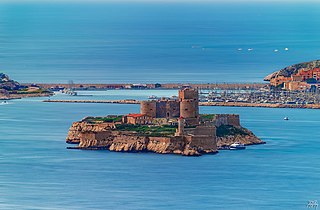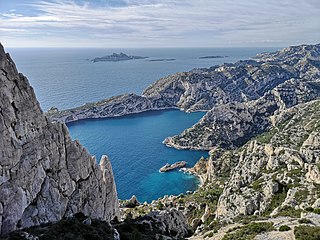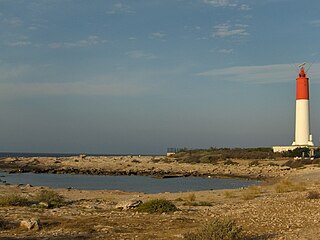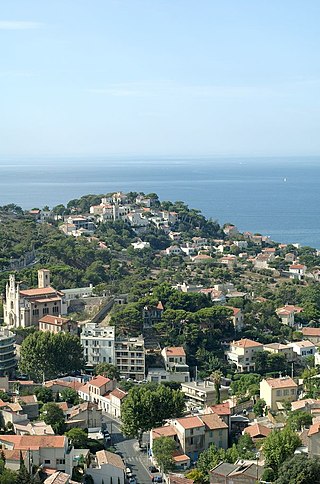
The Château d'If is a fortress located on the Île d'If, the smallest island in the Frioul archipelago, situated about 1.5 kilometres offshore from Marseille in southeastern France. Built in the 16th century, it later served as a prison until the end of the 19th century. The fortress was demilitarized and opened to the public in 1890. It is famous for being one of the settings of Alexandre Dumas's adventure novel The Count of Monte Cristo. It is one of the most visited sites in the city of Marseille.

The Chalk Group is the lithostratigraphic unit which contains the Upper Cretaceous limestone succession in southern and eastern England. The same or similar rock sequences occur across the wider northwest European chalk 'province'. It is characterised by thick deposits of chalk, a soft porous white limestone, deposited in a marine environment.

The Stade Vélodrome, known for sponsorship reasons as the Orange Vélodrome since June 2016, is a multi-purpose stadium in Marseille, France. It is home to the Olympique de Marseille football club of Ligue 1 since it opened in 1937, and has been a venue in the 1938 and 1998 FIFA World Cups; the 1960, 1984 and 2016 editions of the UEFA European Championship; and the 2007 and 2023 Rugby World Cup. It occasionally hosts RC Toulon rugby club of the Top 14. It is the second largest stadium in France, behind Stade de France in Saint-Denis (Paris), with a capacity of 67,394 spectators. The stadium is also used regularly by the France national rugby union team.

La Ciotat is a commune in the Bouches-du-Rhône department in the Provence-Alpes-Côte d'Azur region in Southern France. It is the southeasternmost commune of the Aix-Marseille-Provence Metropolis. La Ciotat is located at about 25 km (15.5 mi) to the east of Marseille, at an equal distance from Toulon.

A calanque is a narrow, steep-walled inlet that is developed in limestone, dolomite, or other carbonate strata and found along the Mediterranean coast. A calanque is a steep-sided valley formed within karstic regions either by fluvial erosion or the collapse of the roof of a cave that has been subsequently partially submerged by a rise in sea level.

Cassis is a commune situated east of Marseille in the department of Bouches-du-Rhône in the Provence-Alpes-Côte d'Azur region, whose coastline is known in English as the French Riviera, in Southern France.
The Cenomanian is, in the International Commission on Stratigraphy's (ICS) geological timescale, the oldest or earliest age of the Late Cretaceous Epoch or the lowest stage of the Upper Cretaceous Series. An age is a unit of geochronology; it is a unit of time; the stage is a unit in the stratigraphic column deposited during the corresponding age. Both age and stage bear the same name.

The Turonian is, in the ICS' geologic timescale, the second age in the Late Cretaceous Epoch, or a stage in the Upper Cretaceous Series. It spans the time between 93.9 ± 0.8 Ma and 89.8 ± 1 Ma. The Turonian is preceded by the Cenomanian Stage and underlies the Coniacian Stage.

The Corniche des Crêtes is a picturesque and narrow coastal road in Southern France, winding from Cassis to La Ciotat in Bouches-du-Rhône, along the Mediterranean shore.

Cosquer Cave is located in the Calanque de Morgiou in Marseille, France, near Cap Morgiou. The entrance to the cave is located 37 m (121 ft) underwater, due to the Holocene sea level rise. The cave contains various prehistoric rock art engravings. Its submarine entrance was discovered in 1985 by Henri Cosquer, a professional diver. The underwater passage leading to the cave was progressively explored until 1990 by cave divers without the divers being aware of the archaeological character of the cave. It is only in the last period (1990–1991) of the progressive underwater explorations that the cave divers emerged in the non-submerged part of the cave. The prehistoric paintings were not immediately discovered by the divers to first emerge from the other side of the sump. The cave was named after Henri Cosquer, when its existence was made public in 1991, after three divers became lost in the cave and died.

The Opéra de Marseille, known today as the Opéra Municipal, is an opera company located in Marseille, France. In 1685, the city was the second in France after Bordeaux to have an opera house which was erected on a tennis court.

The Massif des Calanques is a wild and rugged terrain stretching from the ninth arrondissement of Marseille to the east towards Cassis, spanning 20 km in length and 4 km in width along the coast. Its highest peak is Mont Puget at 565m. The area has been protected by a national park since 2012.

Centrale Méditerranée, formerly known as École Centrale de Marseille is a leading graduate school of engineering located in Marseille, the second largest city in France. Centrale Méditerranée was created in 2006 by the merging of different previous institutions and has its origins from the École d'Ingénieurs de Marseille founded in 1891. As a successor school of the latter, it is one of the oldest French engineering Grande école, and is amongst the best engineering school of France.

La Canebière is a historic high street in the old quarter of Marseille, France.

La Couronne is a village in the south of France on the Côte Bleue on the Mediterranean coast, notable for its ancient quarries and lighthouses.

The Palais Longchamp is a monument in the 4th arrondissement of Marseille, France. It houses both the Musée des beaux-arts and the Muséum d'histoire naturelle de Marseille. The surrounding Longchamp Park is listed by the French Ministry of Culture as one of the Notable Gardens of France.

Bompard is a quarter in the 7th arrondissement of Marseille, France. According to the 2012 INSEE census, it had a population of 4,220.
The Ligérian is a regional geological substage of the Turonian. It designates sediments of the Lower Turonian in western France.

Julien Schwarzer, known professionally as SCH, is a French rapper from Marseille.
Richard Martin was a French theatre director, playwright, and actor known for The Woman Cop, Cap Canaille, and Too Beautiful for You. Martin was born in Nice in 1943, and died on 16 October 2023, at the age of 80.

















